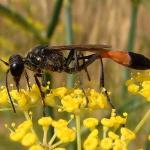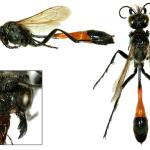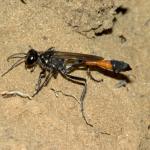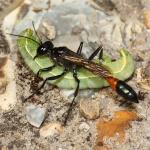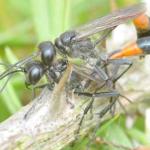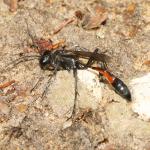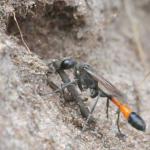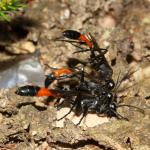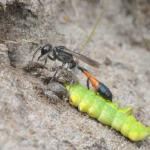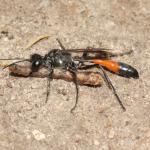This is a conspicuous and relatively large solitary species.
Found throughout much of Britain, though more often seen in southern England. Of special note are the Scottish records; also, the limited distribution of the species in Ireland, which may not be entirely a result of under-recording in that country.
This species is not regarded as being threatened.
This wasp inhabits heathland, dunes and other coastal areas.
June-September.
Various Lepidoptera larvae; rarely sawfly larvae (Richards, 1980).
A detailed study of the behaviour and ecology of marked A. sabulosa females has been made at a Breckland heathland site (Field, 1992). Nests usually occur at relatively low densities. Normally, a female digs a short burrow, ending in a horizontal cell, in bare or sparsely vegetated sand. Later, she temporarily closes the nest entrance using sand and tiny stones, then hunts for lepidopteran caterpillars in vegetation. About half of all cells are provisioned with just one large caterpillar, which is carried back on foot as it is sometimes more than ten times as heavy as the wasp. Other cells are provisioned with two to five smaller caterpillars (see Olberg, 1959). An egg is laid on the first caterpillar provisioned and rarely hatches before permanent closure of the nest burrow. After the last caterpillar has been interred the wasp permanently closes the burrow with a much deeper plug of sand, and camouflages the entrance with debris so that it is invisible to the human eye. All nests are unicellular. The whole nesting cycle, from searching for a digging site to closing the nest permanently after provisioning, takes an average of eight to ten hours of activity. Marked females each dug and provisioned up to ten nests during a summer.
One of the most interesting aspects of this species' behaviour is that almost all females, as well as digging their own burrows and hunting for prey, parasitise the freshly provisioned nests of other A. sabulosa. When a female detects a conspecific's nest she digs through the closure plug and enters. If the nest is empty, she quickly comes out and re-closes it; but if it contains prey, she either steals one of the prey items, or eats the host's egg, replacing it with her own (brood parasitism). Some 28% of eggs laid in their own nests are later destroyed by conspecific brood-parasites and prey thieves. Some nests are brood-parasitised up to four times, each time by a different female. Miltogrammine flies (Metopia spp.) destroy another 5% of A. sabulosa eggs, so that overall only about two-thirds survive to hatch.
1997


